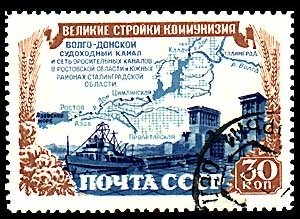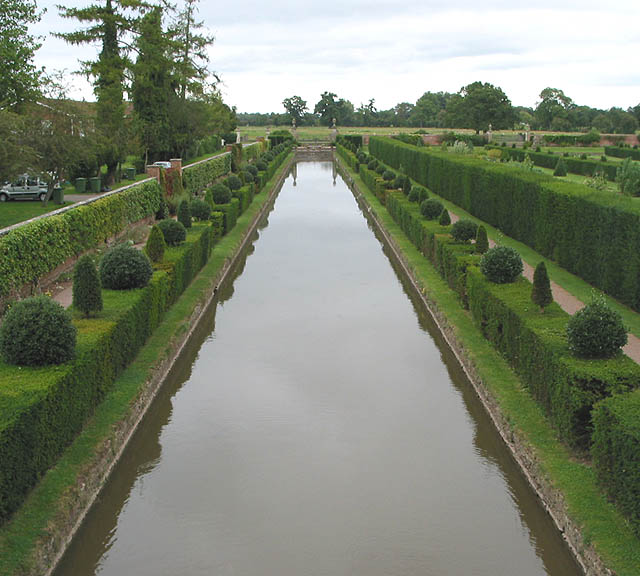Stamp: Volga-Don canal's map and hydroengineering construstions (Soviet Union, USSR 1951)
Volga-Don canal's map and hydroengineering construstions (Soviet Union, USSR 1951)
01 January (Soviet Union, USSR ) within release 25th Anniversary of Volkhov Hydroelectric Plant goes into circulation Stamp Volga-Don canal's map and hydroengineering construstions face value 30 Russian kopek
| Stamp Volga-Don canal's map and hydroengineering construstions in catalogues | |
|---|---|
| Michel: | Mi:SU 1602 |
Stamp is square format.
Also in the issue 25th Anniversary of Volkhov Hydroelectric Plant:
- Stamp - The dam and bas-relief of Lenin & Stalin face value 40;
- Stamp - Kakhovka Hydroelectric Power Plant face value 20;
- Stamp - Volga-Don canal's map and hydroengineering construstions face value 30;
- Stamp - Dam of Stalingrad Hydroelectric Power Plant face value 40;
- Stamp - Main Turkmen Canal [unbuilt] and cotton-plants face value 60;
- Stamp - Equestrian statue of Jan Žižka in Praha face value 20;
- Stamp - Monument to soldiers of Soviet Army in Ostrava face value 25;
- Stamp - Julius Fučík (1903-1943), Czechoslovak author face value 40;
- Stamp - Building of Bedřich Smetana Museum in Praha face value 60;
- Stamp - Volkhov Hydroelectric Plant named after V.I. Lenin face value 40;
- Stamp - Budapest: Liberty Bridge face value 25;
- Stamp - Budapest: Parliament face value 40;
- Stamp - Budapest: National Museum face value 60;
- Stamp - Combine harvester face value 25;
- Stamp - Meadow, grasses, insects and beehive face value 40;
- Stamp - Citrus harvesting face value 1;
- Stamp - M.I. Kalinin Museum in Moscow face value 20;
- Stamp - Mikhail I. Kalinin (1875-1946), Soviet statesman face value 40;
- Stamp - Felix E. Dzerzhinsky (1877-1926), Soviet statesman face value 40;
|
Data entry completed
43%
|
|
|---|---|
| Stamp Volga-Don canal's map and hydroengineering construstions in digits | |
| Country: | Soviet Union, USSR |
| Date: | 1951-01-01 |
| Format: | Stamp |
| Face Value: | 30 Russian kopek |
Stamp Volga-Don canal's map and hydroengineering construstions it reflects the thematic directions:
A map is a symbolic depiction emphasizing relationships between elements of some space, such as objects, regions, or themes. Many maps are static, fixed to paper or some other durable medium, while others are dynamic or interactive. Although most commonly used to depict geography, maps may represent any space, real or imagined, without regard to context or scale, such as in brain mapping, DNA mapping, or computer network topology mapping. The space being mapped may be two dimensional, such as the surface of the earth, three dimensional, such as the interior of the earth, or even more abstract spaces of any dimension, such as arise in modeling phenomena having many independent variables. Although the earliest maps known are of the heavens, geographic maps of territory have a very long tradition and exist from ancient times. The word "map" comes from the medieval Latin Mappa mundi, wherein mappa meant napkin or cloth and mundi the world. Thus, "map" became the shortened term referring to a two-dimensional representation of the surface of the world.
An economy is an area of the production, distribution and trade, as well as consumption of goods and services. In general, it is defined as a social domain that emphasize the practices, discourses, and material expressions associated with the production, use, and management of resources. A given economy is a set of processes that involves its culture, values, education, technological evolution, history, social organization, political structure, legal systems, and natural resources as main factors. These factors give context, content, and set the conditions and parameters in which an economy functions. In other words, the economic domain is a social domain of interrelated human practices and transactions that does not stand alone.
A diagram is a symbolic representation of information using visualization techniques. Diagrams have been used since prehistoric times on walls of caves, but became more prevalent during the Enlightenment. Sometimes, the technique uses a three-dimensional visualization which is then projected onto a two-dimensional surface. The word graph is sometimes used as a synonym for diagram
Communism (from Latin communis, 'common, universal') is a left-wing to far-left sociopolitical, philosophical, and economic ideology within the socialist movement, whose goal is the creation of a communist society, a socioeconomic order centered around common ownership of the means of production, distribution, and exchange that allocates products to everyone in the society based on need. A communist society would entail the absence of private property and social classes, and ultimately moneyand the state (or nation state).
Canals or artificial waterways are waterways or engineered channels built for drainage management (e.g. flood control and irrigation) or for conveyancing water transport vehicles (e.g. water taxi). They carry free, calm surface flow under atmospheric pressure, and can be thought of as artificial rivers




